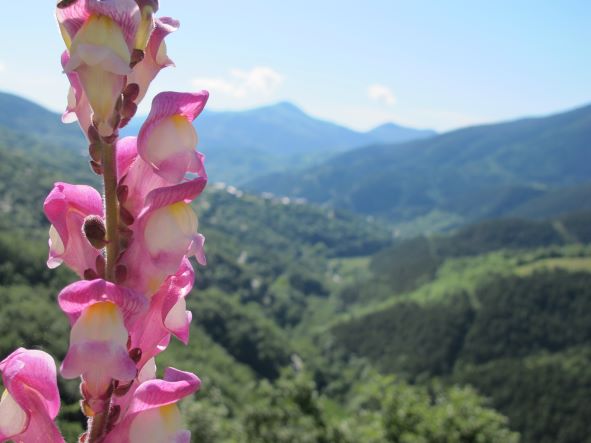July 20, 2022
How Flowers Protect Themselves from Bad Genes
Plants fight against inbreeding

For more than ten years now, a research group at the Institute of Science and Technology Austria (ISTA) in Klosterneuburg has been studying the relationships between magenta and yellow flowers in Catalonia, Spain. These snapdragons, which grow mainly in the western Mediterranean area, have evolved an ingenious system to prevent bad genes from being brought together when related plants pollinate them.
Nick Barton sits in the shade of a large pine tree and casts a glance at the valley that spreads out before him. The fairytale landscape of Catalonia in northern Spain will be his workplace for the next few weeks. That’s because Barton, a biologist and professor at the Institute of Science and Technology Austria (ISTA) in Klosterneuburg, is studying the population of snapdragons there. These are colorful, tall flowers that are often sold as ornamental plants because of their beauty. Why do the scientist and his team travel so far for their research? “It’s not the idyllic area and the quietness of this valley,” he jokes, ”because snapdragons grow mainly on the side of the road. That makes our work not only more uncomfortable because cars and motorbikes roar by at high speeds, but also a little more dangerous. ”For the past ten years, Barton has been traveling to the area with his colleagues and volunteers to study the snapdragons’ populations, using their genetic make-up to determine their family relationships. Because some of these plants are inbreeding.
Genetic material from relatives
There are about 3,000 snapdragons along the five kilometers of the valley. So, the plants grow relatively close to each other. ”With pine trees, inbreeding is not a big problem,” Barton says looking at the tree next to him, ”because vast forests of pines release their pollen, which is blown over long distances until it fertilizes other trees. Snapdragons, on the other hand, grow close to each other and are pollinated by bumblebees – often only within a 50-meter radius.” Inbreeding in plants has the same effects as in humans: by bringing together defective genes, it leads to “inbreeding depression”, which means that the resulting plant is weaker and not as healthy as others.
When a child is conceived, whether in humans, animals, or plants, it receives one set of genes from the father, and one from the mother. These genes are extraordinarily diverse – each set of genes typically differs at several million sites from the other. When a parent passes on their set of genes to the next generation, they are reshuffled, generating a new and unique combination of genes – which is why every person and every plant looks a little different. In snapdragons, scientists know of half a dozen genes that influence the differences in flower color that they study – but these are only a tiny fraction of the total genetic code.
Genes are continually at risk from random mutation, which can generate defective genes. Each individual carries two copies of each gene, and if only one is defective, this typically does little harm. However, an inbred individual can inherit a defective copy of the same gene from its father and from its mother – and when this happens, the health of the plant can be severely reduced.
Surprising revelation

“What surprised us was that snapdragons don’t inbreed as much as we had expected, given the modest numbers that we see growing each year,” Barton says. “Plants have evolved extraordinary mechanisms to stop inbreeding, which prevents inbreeding depression, and also helps to preserve the diversity that is essential for populations to be able to adapt to changing conditions.”
This is necessary, because most flowering plants combine male and female function in the same individual. They produce ovules that are fertilized by pollen, producing the seeds that produce the next generation. To prevent self-fertilization, the sex organs of one plant may be far apart, or active only at different times; and some plants may be purely male or female. Perhaps most remarkable is a molecular mechanism, the ”S locus“. It is a highly diverse gene, which makes the plant destroy any pollen that carries the same type of gene as itself. This is what the snapdragons use. ”So if the pollen comes from itself, or from a close relative, the plant cannot be successfully pollinated. It’s an ingenious mechanism,” the ISTA professor adds.
He says: “We studied more than 20,000 individual plants over a decade, collecting leaves in order to sequence DNA from the entire population. That allowed us to estimate parent-child relationships between the plants across the years, so that we can find out how many descendants each plant produced. Ultimately, it is these differences in reproductive output that determine the course of evolution. Just a few years ago, finding the DNA sequence of so many plants would have been unthinkable.”
Seeds take their time
So far, the team has identified more than 2,000 trios – mother, father and child, if you will. What astonished the biologists was that plants from one year hardly ever had parents in the batch from the previous year – in the first years of the project, they could hardly find any parents. “Then, we understood,” Barton says, “that seeds that fall to the ground typically stay dormant for two or three years until they produce descendants. That doesn’t happen in a greenhouse, where new plants grow immediately. So, because the seeds take their time, there is much less inbreeding, because relatives are separated by time as well as space.
A Huge effort
Long-term research projects like the one conducted by Professor Nick Barton and his research group are crucial for understanding natural systems – yet, it is difficult to sustain funding for them over many years. “ISTA has a unique commitment to supporting basic research, and its steady funding has allowed us to continue our work,” Barton says. “For us, the project is about understanding the reproductive systems of flowers in a fundamental way. We want to understand the evolution of these resourceful systems that inhibit inbreeding, helping species preserve diversity, so that they can continue to evolve. Understanding how small populations can adapt to changing conditions, despite inbreeding, will be crucial for understanding how to save species from extinction.”
Publication
Parvathy Surendranadh, Louise Arathoon , Carina A. Baskett, David L. Field, Melinda Pickup and Nicholas H. Barton, 2022. Effects of fine-scale population structure on the distribution of heterozygosity in a long-term study of Antirrhinum majus. Genetics. DOI: https://doi.org/10.1093/genetics/iyac083
Funding information
The ISTA project part was supported by funding from the FWF.



